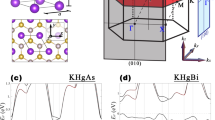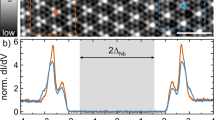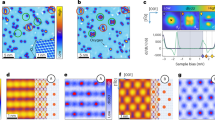Abstract
The tunability of topological surface states and controllable opening of the Dirac gap are of fundamental and practical interest in the field of topological materials. In the newly discovered topological crystalline insulators (TCIs), theory predicts that the Dirac node is protected by a crystalline symmetry and that the surface state electrons can acquire a mass if this symmetry is broken. Recent studies have detected signatures of a spontaneously generated Dirac gap in TCIs; however, the mechanism of mass formation remains elusive. In this work, we present scanning tunnelling microscopy (STM) measurements of the TCI Pb1−xSnxSe for a wide range of alloy compositions spanning the topological and non-topological regimes. The STM topographies reveal a symmetry-breaking distortion on the surface, which imparts mass to the otherwise massless Dirac electrons—a mechanism analogous to the long sought-after Higgs mechanism in particle physics. Interestingly, the measured Dirac gap decreases on approaching the trivial phase, whereas the magnitude of the distortion remains nearly constant. Our data and calculations reveal that the penetration depth of Dirac surface states controls the magnitude of the Dirac mass. At the limit of the critical composition, the penetration depth is predicted to go to infinity, resulting in zero mass, consistent with our measurements. Finally, we discover the existence of surface states in the non-topological regime, which have the characteristics of gapped, double-branched Dirac fermions and could be exploited in realizing superconductivity in these materials.
This is a preview of subscription content, access via your institution
Access options
Subscribe to this journal
Receive 12 print issues and online access
$259.00 per year
only $21.58 per issue
Buy this article
- Purchase on Springer Link
- Instant access to full article PDF
Prices may be subject to local taxes which are calculated during checkout






Similar content being viewed by others
References
Fu, L. Topological crystalline insulators. Phys. Rev. Lett. 106, 106802 (2011).
Hsieh, T. H. et al. Topological crystalline insulators in the SnTe material class. Nature Commun. 3, 982 (2012).
Okada, Y. et al. Observation of Dirac node formation and mass acquisition in a topological crystalline insulator. Science 341, 1496–1499 (2013).
Zeljkovic, I. et al. Mapping the unconventional orbital texture in topological crystalline insulators. Nature Phys. 10, 572–577 (2014).
Hsieh, D. et al. A topological Dirac insulator in a quantum spin Hall phase. Nature 452, 970–974 (2008).
Xia, Y. et al. Observation of a large-gap topological-insulator class with a single Dirac cone on the surface. Nature Phys. 5, 398–402 (2009).
Chen, Y. L. et al. Experimental realization of a three-dimensional topological insulator, Bi2Te3 . Science 325, 178–181 (2009).
Hsieh, D. et al. A tunable topological insulator in the spin helical Dirac transport regime. Nature 460, 1101–1105 (2009).
Roushan, P. et al. Topological surface states protected from backscattering by chiral spin texture. Nature 460, 1106–1109 (2009).
Fu, L., Kane, C. & Mele, E. Topological insulators in three dimensions. Phys. Rev. Lett. 98, 106803 (2007).
Qi, X-L. & Zhang, S-C. Topological insulators and superconductors. Rev. Mod. Phys. 83, 1057–1110 (2011).
Hasan, M. Z. & Kane, C. L. Colloquium: Topological insulators. Rev. Mod. Phys. 82, 3045–3067 (2010).
Serbyn, M. & Fu, L. Symmetry breaking and Landau quantization in topological crystalline insulators. Phys. Rev. B 90, 035402 (2014).
Dziawa, P. et al. Topological crystalline insulator states in Pb1−xSnxSe. Nature Mater. 11, 1023–1027 (2012).
Xu, S-Y. et al. Observation of a topological crystalline insulator phase and topological phase transition in Pb1−xSnxTe. Nature Commun. 3, 1192 (2012).
Hashimoto, K. et al. Quantum Hall transition in real space: From localized to extended states. Phys. Rev. Lett. 101, 256802 (2008).
Li, G. & Andrei, E. Y. Observation of Landau levels of Dirac fermions in graphite. Nature Phys. 3, 623–627 (2007).
Hanaguri, T., Igarashi, K., Kawamura, M., Takagi, H. & Sasagawa, T. Momentum-resolved Landau-level spectroscopy of Dirac surface state in Bi2Se3 . Phys. Rev. B 82, 081305 (2010).
Soumyanarayanan, A. et al. Imaging the nanoscale band structure of topological Sb. Preprint at http://arxiv.org/abs/1311.1758 (2013)
Agnihotri, O. P., Jain, A. K. & Gupta, B. K. X-ray investigations on Bridgeman-grown Pb1−xSnxTe single crystals. Mater. Sci. Eng. 38, 33–34 (1979).
Gyenis, A. et al. Quasiparticle interference on the surface of the topological crystalline insulator Pb1−xSnxSe. Phys. Rev. B 88, 125414 (2013).
Klijn, J. et al. STM measurements on the InAs(110) surface directly compared with surface electronic structure calculations. Phys. Rev. B 68, 205327 (2003).
Lawler, M. J. et al. Intra-unit-cell electronic nematicity of the high-Tc copper-oxide pseudogap states. Nature 466, 347–351 (2010).
Zeljkovic, I. et al. Scanning tunnelling microscopy imaging of symmetry-breaking structural distortion in the bismuth-based cuprate superconductors. Nature Mater. 11, 585–589 (2012).
Snykers, M., Delavignette, P. & Amelinckx, S. The domain structure of GeTe as observed by electron microscopy. Mater. Res. Bull. 7, 831–839 (1972).
Linder, J., Yokoyama, T. & Sudbø, A. Anomalous finite size effects on surface states in the topological insulator Bi2Se3 . Phys. Rev. B 80, 205401 (2009).
Tanaka, Y. et al. Experimental realization of a topological crystalline insulator in SnTe. Nature Phys. 8, 800–803 (2012).
Tanaka, Y. et al. Tunability of the k-space location of the Dirac cones in the topological crystalline insulator Pb1−xSnxTe. Phys. Rev. B 87, 155105 (2013).
Hoesch, M. et al. Spin structure of the Shockley surface state on Au(111). Phys. Rev. B 69, 241401 (2004).
LaShell, S., McDougall, B. & Jensen, E. Spin splitting of an Au(111) surface state band observed with angle resolved photoelectron spectroscopy. Phys. Rev. Lett. 77, 3419–3422 (1996).
Wojek, B. et al. Spin-polarized (001) surface states of the topological crystalline insulator Pb0.73Sn0.27Se. Phys. Rev. B 87, 115106 (2013).
Yan, C. et al. Experimental observation of Dirac-like surface states and topological phase transition in Pb1−xSnxTe(111) films. Phys. Rev. Lett. 112, 186801 (2014).
Goldstein, G., Aron, C. & Chamon, C. Band-edge superconductivity. Preprint at http://arxiv.org/abs/1410:6103 (2014)
Liu, J., Duan, W. & Fu, L. Two types of surface states in topological crystalline insulators. Phys. Rev. B 88, 241303 (2013).
Acknowledgements
We thank R. Buczko, C. Chamon, J. C. Seamus Davis, M. El-Batanouny, A. Mesaros, Y. Ran and A. Soumyanarayanan for useful conversations and G. McMahon for help with EDS measurements. V.M. gratefully acknowledges funding from the US Department of Energy, Scanned Probe Division under Award Number DE-FG02-12ER46880 for the support of I.Z., Y.O., W.Z. and D.W. for this project. Work at Massachusetts Institute of Technology is supported by US Department of Energy, Office of Basic Energy Sciences, Division of Materials Sciences and Engineering under Award DE-SC0010526 (L.F.), and NSF-DMR-1104498 (M.S.). H.L. acknowledges the Singapore National Research Foundation for support under NRF Award No. NRF-NRFF2013-03. Y.O. was partly supported by JSPS KAKENHI Grant Numbers 26707016 and 00707656. The work at Northeastern University is supported by the US Department of Energy grant number DE-FG02-07ER46352, and benefited from Northeastern University’s Advanced Scientific Computation Center (ASCC), theory support at the Advanced Light Source, Berkeley and the allocation of supercomputer time at the NERSC through DOE grant number DE-AC02-05CH11231. Work at Princeton University is supported by the US National Science Foundation Grant, NSF-DMR-1006492. F.C. acknowledges the support provided by MOST-Taiwan under project number NSC-102-2119-M-002-004.
Author information
Authors and Affiliations
Contributions
Y.O. and I.Z. contributed equally to this work. Y.O., I.Z. and V.M. designed the experiments. STM experiments were carried out by Y.O., I.Z., D.W. and W.Z. I.Z., Y.O., L.F. and V.M. analysed the data and wrote the paper. Samples were obtained from R.S., F.C. and M.Z.H. F.C. and R.S. contributed to the single-crystal growth and structural analysis. L.F. conceived the theoretical explanation for this work. M.S. performed analytical model calculations. H.L. and A.B. supervised the first-principles part of the work, which was performed by G.C., Y.J.W., J.L. and H.L.
Corresponding authors
Ethics declarations
Competing interests
The authors declare no competing financial interests.
Supplementary information
Supplementary Information
Supplementary Information (PDF 1144 kb)
Rights and permissions
About this article
Cite this article
Zeljkovic, I., Okada, Y., Serbyn, M. et al. Dirac mass generation from crystal symmetry breaking on the surfaces of topological crystalline insulators. Nature Mater 14, 318–324 (2015). https://doi.org/10.1038/nmat4215
Received:
Accepted:
Published:
Issue Date:
DOI: https://doi.org/10.1038/nmat4215
This article is cited by
-
Energy gap of topological surface states in proximity to a magnetic insulator
Communications Physics (2023)
-
Plethora of tunable Weyl fermions in kagome magnet Fe3Sn2 thin films
npj Quantum Materials (2022)
-
Probing topological quantum matter with scanning tunnelling microscopy
Nature Reviews Physics (2021)
-
Visualizing coexisting surface states in the weak and crystalline topological insulator Bi2TeI
Nature Materials (2020)
-
Interplay of orbital effects and nanoscale strain in topological crystalline insulators
Nature Communications (2018)



